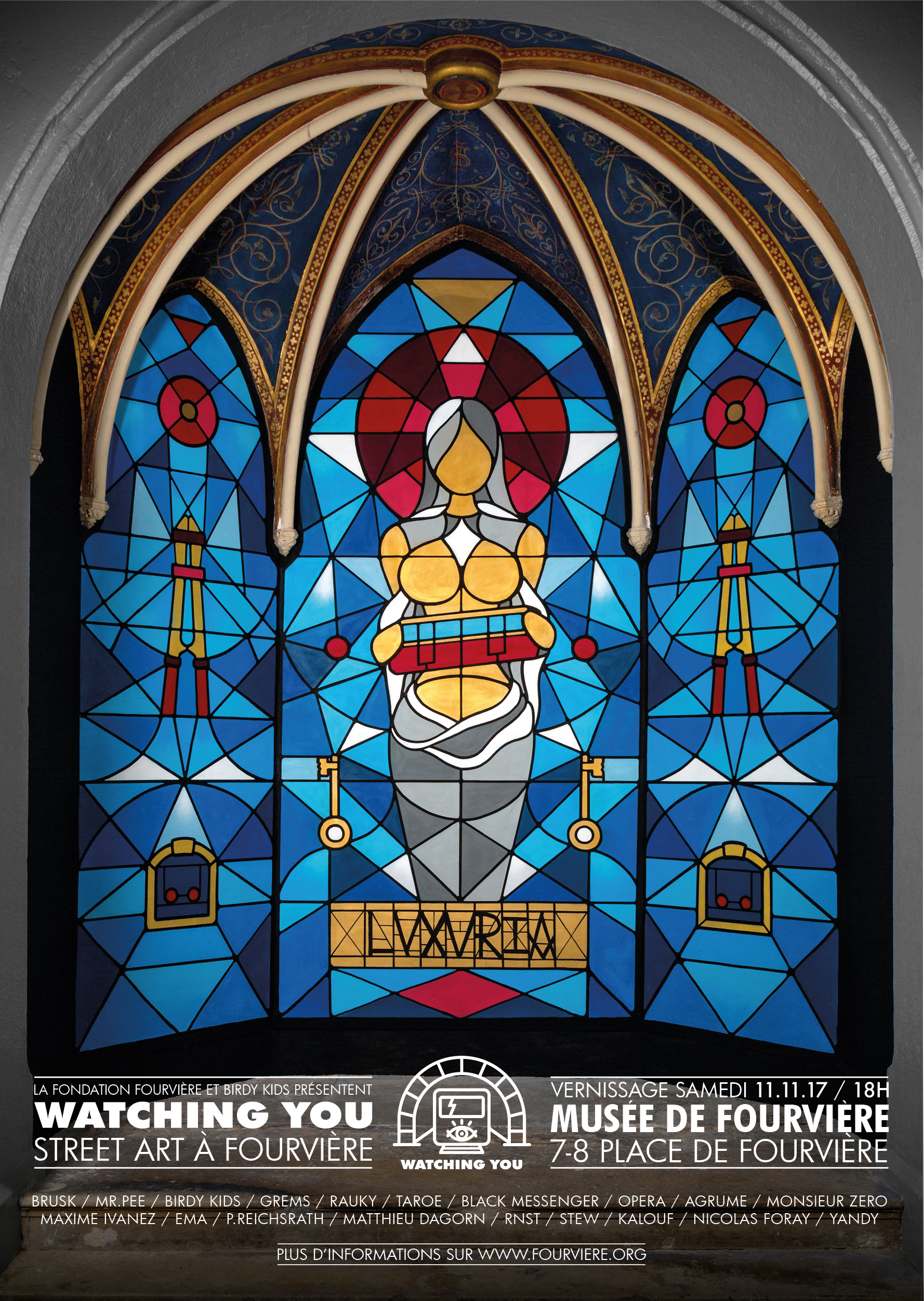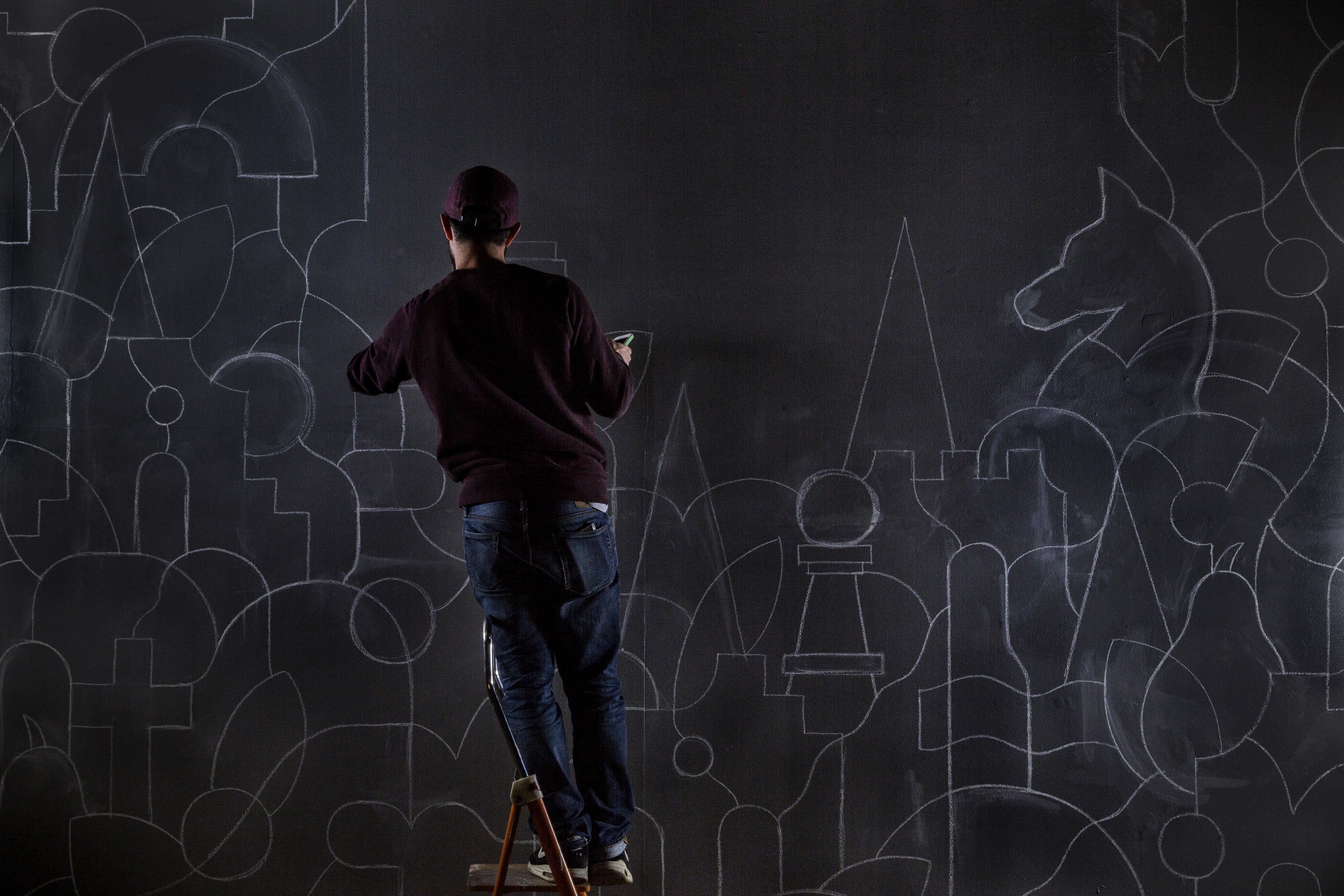Employer : Birdy Kids Client : Musée de Fourvières
Press : Inside-lyon / Happycurio / Lyonhiphop / Lebonbon
Crédits : Photos / Stéphane Vignal
Press : Inside-lyon / Happycurio / Lyonhiphop / Lebonbon
Crédits : Photos / Stéphane Vignal

As part of its rehabilitation, the Fourvière museum in Lyon teamed up with the Birdy Kids collective to create an ephemeral collective exhibition called WATCHING YOU.
For the museum that will close its doors for major restoration and expansion works, this was the opportunity, one last time, to revive its walls, before a more sustainable transformation of the place. 18 international artists were invited to show large paintings in the different rooms of the old chapel. The public will be able to discover them until the end of January 2018.
Succes of the inauguration
With more than 2200 people on the evening of Saturday 11 November 2017 for the inauguration and 850 visitors on Sunday afternoon, more than 3000 people came to discover the unique exhibition of Street Art at the Fourvière museum the first weekend.
For the museum that will close its doors for major restoration and expansion works, this was the opportunity, one last time, to revive its walls, before a more sustainable transformation of the place. 18 international artists were invited to show large paintings in the different rooms of the old chapel. The public will be able to discover them until the end of January 2018.
Succes of the inauguration
With more than 2200 people on the evening of Saturday 11 November 2017 for the inauguration and 850 visitors on Sunday afternoon, more than 3000 people came to discover the unique exhibition of Street Art at the Fourvière museum the first weekend.
Dans le cadre de sa réhabilitation, le musée Fourvière de Lyon s’est associé au collectif Birdy Kids pour créer une exposition collective éphémère intitulée WATCHING YOU. Pour le musée qui fermera ses portes pour d'importants travaux de restauration et d'agrandissement, c'était l'occasion, une dernière fois, de faire revivre ses murs, avant une transformation plus durable des lieux. 18 artistes internationaux ont été invités à exposer de grands tableaux dans les différentes salles de l'ancienne chapelle. Le public pourra les découvrir jusqu'à fin janvier 2018.
Succès de l'inauguration
Avec plus de 2200 personnes dans la soirée du samedi 11 novembre 2017 pour l'inauguration et 850 visiteurs le dimanche après-midi, plus de 3000 personnes sont venues découvrir l'exposition unique du Street Art au musée de Fourvière le premier week-end.
Succès de l'inauguration
Avec plus de 2200 personnes dans la soirée du samedi 11 novembre 2017 pour l'inauguration et 850 visiteurs le dimanche après-midi, plus de 3000 personnes sont venues découvrir l'exposition unique du Street Art au musée de Fourvière le premier week-end.
ARTISTS : BRUSK / MR. PEE / BIRDY KIDS / GREMS / TAROE / OPÉRA / BLACK MESSENGER / RAUKY /AGRUME / MONSIEUR ZERO / MAXI
ME IVANEZ / EMA / P.REICHSRATH / MATHIEU DAGORNE / STEW / KALOUF / NICOLAS FORAY / YANDY GRAFFER

“THE PASSAGE”
The painting done by the artist, highlighting a chessboard, i an allegory strongly representative of the man in the society and his archetypes through the centuries.
From India to Persia, from the Islamic world to the Christian West, the travels of the "noble game" of chess span almost five hundred years ... It is an initiatory game, largely symbolic and sacred.
A theater of figures and numbers. This game born in India, then transformed into Persia, is remodeled by the Arab civilization.
Apart from its symbolic kinship with military art, all or almost all is foreign to the Christians of the year one thousand. To assimilate it, they have everythin first of all, to adapt it to their own codes: to renounce chance, to transform pieces and give them a more symbolic dimension ....
It is indeed a certain fight between black pieces and white pieces between shadow and light or between good and bad ... the challenge is always, and in in all cases, supremacy over the world.
It took more than two centuries, between the eleventh and XIIIth centuries, for a slow acculturation of the people transforms the game warrior in a more courteous game, well in line with the values of the medieval society of the time. Spread in the cities and the countryside, and winning all the layers of society, the game of chess first serves ecclesiastics a moralisation of morals.Under the authority of Pope Innocent III, the Innocent Morality Treaty is circulated in all over Europe and relayed by sermons in churches.
He declares that "the world looks like the black checkered chessboard and white, these two colors symbolizing the conditions of life and death, of goodness and sin.
The figurines being the men of this world, occupying the positions and jobs, and having the titles assigned to them in this life, united by the same destiny despite their respective conditions different."
“LE PASSAGE”
La peinture réalisée par l’artiste, mettant en exergue un échiquier, est une allégorie fortement représentatrice de l’homme au sein de la société et ses archétypes à travers les siècles.
De l'Inde vers la Perse, du monde islamique vers l'Occident chrétien, les voyages du "noble jeu" des échecs s'étendent sur près de cinq cents ans…. C’est un jeu initiatique, à grande part symbolique et sacré. Un théâtre de figures et de nombres. Ce jeu né aux Indes, puis transformé en Perse, est remodelé par la civilisation arabe.
Mis à part sa parenté symbolique avec l'art militaire, tout ou presque y est étranger aux chrétiens de l'an mille. Pour l'assimiler, ceux-ci ont tout d’abord dû l’adapter à leurs propres codes : renoncer au hasard, transformer les pièces et leur conférer une dimension plus symbolique….
C’est en effet un combat certain entre pièces noires et pièces blanches, entre ombre et lumière ou encore entre bien et mal… l’enjeu est toujours, et dans tous les cas, la suprématie sur le monde.
Il aura donc fallut plus de deux siècles, entre les XIe et XIIIe siècles, pour qu'une lente acculturation du peuple transforme le jeu guerrier en un jeu plus courtois, bien en adéquation avec les valeurs de la société médiévale de l’époque. Répandu dans les villes et les campagnes, et gagnant toutes les couches de la société, le jeu d’échecs sert d’abord les ecclésiastiques entreprennant une moralisation des mœurs.
Placé sous l'autorité du pape Innocent III, le traité Innocente Moralité est diffusé dans toute l'Europe et relayé par des sermons dans les églises.
Il déclare que "le monde ressemble à l'échiquier quadrillé de noir et blanc, ces deux couleurs symbolisant les conditions de vie et de mort, de bonté et de péché. Les figurines étant les hommes de ce monde, occupant les charges et les emplois, et disposant des titres qui leur sont dévolus dans cette vie, réunis par une même destinée malgré leurs conditions respectives différentes".




